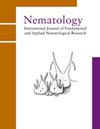苏africana n. sp.(横纹肌目,横纹肌科),一新种,短尾,产自南非
IF 1.2
4区 生物学
Q2 ZOOLOGY
引用次数: 0
摘要
在2022年的一次土壤线虫调查中,在南非林波波省发现了一种与菊苣草有关的自由生活的食菌线虫,在这里被描述为南非中杆线虫。新物种的特征是相对较长的身体(雌性716-815μm,雄性605-689μm)、长针状物(61-66μm)和引带(22-24μm)以及短尾巴(雌性15-20μm,男性18-21μm)。外阴位于后方(体长的93-95%),外阴到肛门的距离较长(尾部长度的1.5-1.9倍)。此外,该新种有7个侧野切迹和一个peloderan囊,其生殖乳头排列为2/3+ph+1+3,分别为两个阴道前和八个阴道后。28S rDNA BlastN与一种未鉴定的中横纹肌炎(以Bursila(EF990722)保藏)显示出94%的相似性。相比之下,ITS rDNA BlastN显示出82%的相似性,与贫中横纹肌炎(MT710243)。28S和ITS rDNA的系统发育分析将该新种与其他中横纹肌炎分开。提供了南非乳杆菌的描述、测量、插图和SEM显微照片。本文章由计算机程序翻译,如有差异,请以英文原文为准。
Mesorhabditis sudafricana n. sp. (Rhabditida, Mesorhabditidae), a new species with a short tail from South Africa
During a survey of soil nematodes in 2022, a free-living bacterivorous nematode, described here as Mesorhabditis sudafricana n. sp., was discovered in association with kikuyu grass in Limpopo Province, South Africa. The new species was distinguished by a relatively long body (716-815 μm in females and 605-689 μm in males), long spicules (61-66 μm), and gubernaculum (22-24 μm) and a short tail (15-20 μm in females and 18-21 μm in males). The vulva is positioned posteriad (93-95% of body length), and the distance from vulva to anus is long (1.5-1.9 times tail length). Additionally, the new species bears seven lateral field incisures and a peloderan bursa with the genital papillae in arrangement 2/3+ph+1+3, being two precloacal and eight postcloacal. The 28S rDNA BlastN showed 94% similarity with an unidentified Mesorhabditis (deposited as Bursilla (EF990722). By contrast, the ITS rDNA BlastN showed 82% similarity with Mesorhabditis paucipapillata (MT710243). The phylogenetic analysis of 28S and ITS rDNA placed the new species separately from the other Mesorhabditis. Description, measurements, illustrations and SEM micrographs for M. sudafricana n. sp. are provided.
求助全文
通过发布文献求助,成功后即可免费获取论文全文。
去求助
来源期刊

Nematology
生物-动物学
CiteScore
2.60
自引率
33.30%
发文量
67
审稿时长
3 months
期刊介绍:
Nematology is an international journal for the publication of all aspects of nematological research (with the exception of vertebrate parasitology), from molecular biology to field studies. Papers on nematode parasites of arthropods, and on soil free-living nematodes, and on interactions of these and other organisms, are particularly welcome. Research on fresh water and marine nematodes is also considered when the observations are of more general interest.
Nematology publishes full research papers, short communications, Forum articles (which permit an author to express a view on current or fundamental subjects), perspectives on nematology, and reviews of books and other media.
 求助内容:
求助内容: 应助结果提醒方式:
应助结果提醒方式:


